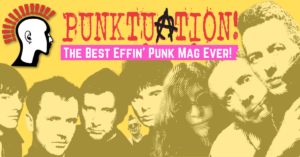If you were a punk in the UK in the ’70s and early ’80s, there were few venues where you could see bands play – the places where you could soon became iconic. Molly Tie takes us on a jaunt around some of the U.K’s better-known original punk venues
If no man is an island, then no punk band is either. It takes a lot of people power to support a punk movement – bands need producers, labels, record shops, promoters, fans and crucially, they also need venues.
During the punk explosion in the 1970s, bands often found it tricky to find places to play as their reputations for destruction and general raucousness spread around. Risk-averse venue owners cancelled gigs, and bands were given the run-around trying to find a place to play.
So, before punk became more mainstream, bands were reliant on ‘thinking outside the box’ as far as venues were concerned.

There were a handful of venues in the U.K. (including one or two bigger clubs) that were so instrumental in nurturing punk during its inception that their very names have become synonymous with punk itself. The clubs themselves became flagship parts of the scene and a place to see and be seen.

Whilst a lot of the most famous punk clubs – with the names we would recognise – were based in London, punk scenes across the U.K. had their own spaces to nurture and promote their own local talent as well as welcoming touring bands from all over the country.
Let’s have a look at some of the most well-known, legendary, or just plain anarchic venues across the U.K.. This is not an exhaustive list, and of course, there will be some that haven’t been included, so feel free to share your own memories in the comments!
London
Starting at the obvious point, it is undeniable that London had some iconic punk venues that played a major part in many punk bands’ careers.
The Roxy was a former fruit and veg warehouse in Covent Garden which became a late-night bar called the Chaguaramas Club in 1970 under the management of reggae record producer Tony Ashfield. It changed hands a few years later and was changed to The Roxy.

In 1976, the new owners – Andrew Czezowski, Susan Carrington, and Barry Jones- put on a series of punk gigs, the first being Billy Idol’s punk outfit Generation X. The Heartbreakers and Siouxsie and the Banshees followed, pushing the Roxy onto the radar of the early punk scene gig-goers. Within the first four months of its opening, it had hosted The Damned, The Jam, Penetration, Sham 69, and The Slits, amongst many others.
“The Roxy was the first place that the punks could think of as their own.” Shane MacGowan
Tweet
It was also the professional home of Don Letts who was the resident DJ at the club and is credited as bringing an appreciation of reggae onto the punk scene by spinning reggae records during his sets.
Considered one of the original punk venues, Shane MacGowan once said of it:
“The Roxy was the first place that the punks could think of as their own.”
Over the years, numerous gigs recordings have been released as live albums, including sets by Buzzcocks, The Adverts and X-Ray Spex.
The Roxy lasted pretty well- only closing down in 2007. It is now the site of a Speedos store but there is a plaque outside announcing that the iconic punk venue once stood there – reminding those who lookup of its hellraising former glory.
Just a mile away in Oxford Street, the 100 Club has been hosting live music since the 1940s. It was originally called the Feldman Swing Club and showcased jazz and swing heavyweights such as Louis Armstrong.
It was changed to the 100 Club in 1964 and like the Roxy, it has seen punk royalty perform within its walls, as well as hosting the 100 Club Punk Festival in 1976.

As well as Buzzcocks, The Jam and the Sex Pistols and their ilk playing there, the 100 Club welcomed bands from the ’80s hardcore scene such as Black Flag and Discharge.
The 100 Club is still going strong and still a popular live music venue. Many big acts play ‘secret’ gigs within its walls which have remained more or less untouched since the 1970s.
It was threatened with closure in 2010 but a concerted campaign to keep it open (and a partnership deal with Converse) has kept its doors open.
Even its earlier incarnation as the Feldman Swing Club has been recognised for its significance, being named one of the 12 UK venues that have made an outstanding contribution to the jazz scene.
London had an embarrassment of riches when it came to high profile punk venues which is understandable as it is the capital of both the country and the punk scene itself and fans from around the country descended on the city to explore the scene.
Amongst all the smaller London venues like the Hope and Anchor, the Tally Ho and The Screen On The Green (one of the oldest cinemas in the UK that saw The Clash, Sex Pistols and Buzzcocks played together there on the night Aug. 29, 1976) there was also:
The Vortex, owned by Andy Czezowski who was also a co-owner of the aforementioned Roxy, opened in 1977 and is mentioned in the lyrics of ‘A’ Bomb in Wardour Street by The Jam. Bands who started their careers at the Vortex include 999, the Boomtown Rats, and Siouxsie and the Banshees. Sadly the club didn’t last long and the last gig at the Vortex was Tubeway Army in 1978.
The Rainbow – (a not so small converted 1930s cinema) was subsumed into punk lore when it became the venue that saw a ‘riot’ take place at a 1977 Clash gig- seats torn up and £1000 of damage caused by fans (the owner put this down to “natural exuberance” rather than malicious damage).
The North East
The North East of England has had a thriving punk scene for decades, and their venues could put on a show and raise hell with the best of them. The North was hit particularly hard by Thatcher’s policies of managed decline and hostility to unions, and so the conditions for punk rebellion were acute and did not disappoint. Different eras have seen different venues welcome punk acts, from The Black Bull to Trillions to the converted warehouse The Garage.
One of the most integral punk venues in the areas was The Station in Gateshead- named as such because it was an old Police social club. Taken over by a collective of punks in the mid-1980s, they have put on shows by numerous underground punk bands such as Blasphemy, Toxic Waste and Conflict. Rumour has it that The Clash played an impromptu set there one night, and a young Björk even graced its stage once when she was touring with her Icelandic post-punk band Kukl.

Photographer and author of a book about The Station Chris Killip, describes the Station fondly as: “a total anarcho-punk zone: black walls, black ceiling, black floor. There was a big sign saying, ‘No glue, no glass bottles,’ but there was a bit of glue-sniffing and gallons of strong cheap cider. Basically, they didn’t have money for better drugs.”
In 2018, Killip published The Station, a large format zine comprising photographs from the venue and now Steidl has published a similarly designed book of his work. Killip chose to concentrate on photographing the audience, though, capturing a vivid record of a time, place and scene that has since attained near-mythic status in the musical history of the north-east.
As well as acting as a venue by night, the building was used as a rehearsal space for local bands by day, meaning its contribution to the local music scene extended beyond just providing a stage but also providing a place for up-and-coming bands to learn their stuff.
Wales
Wales had its own thriving punk scenes, particularly around the cities such as Cardiff, Swansea, and Newport. In Newport, The Stowaway club had rosters to rival that of the big London clubs. The Sex Pistols, Siouxsie and The Banshees, The Pretenders all played at the club during their heyday.

The bands got to hear about the venue thanks to the owner’s trips to the capital to promote the place. It was common for punks from outlying regions to travel into London to frequent certain punk record and clothes shops.
It was this commuting into the capital that helped punks from different areas of the country to meet and spread the word about what was going on in their town. And so, a network of fans, promoters and musicians was born.
Pre-internet, these local contacts and networks were vitally important to ensure that no city or town was left behind as punk spread.
At the forefront of the punk movement in South Wales was Mark Taylor from Cardiff.
Friends with Steve Strange, lead singer of Visage, and nightclub owner Chris Sullivan, Mark would go on to run his own successful punk and new romantic club nights.
“It was exciting. We were into the music, we’d go to gigs at Rudis and the Stowaway in Newport and we dressed how you would expect,” Chris says.
“I was travelling a lot between Cardiff and London and that was where punk was really taking off.

“We would go to the clubs and club nights and it was all about the music. It just progressed from there.
“I remember the Sex Pistols coming down, that was before they played in Caerphilly, they played in Newport and Cardiff.”
Mark started up his own club called Mel’s in Cardiff Docklands with the aim of emulating the ambience of London club The Blitz. The Blitz in Covent Garden was seen as vital to the inception of the New Romantic movement with Boy George, Siobhan Fahey, and Martin Degville as regular clientele.
Mel’s sought to mirror a lot of Blitz’s policies such as that of a strict dress code on the door ensuring that only Wales’ most outrageous and well dressed would make it in. It was an exclusive haven on Bute Street in Cardiff’s docklands for those exploring their individuality.
Scotland
In Scotland, you would assume that Glasgow was the place to be for punk gigs, being a large, cultural city with venues to spare. However, a ‘near-riot’ at a 1976 Stranglers gig was deemed too much for the sensibilities of Glasgow Council and further punk acts were banned from playing in the city.
Step up Paisley – which filled the vacuum of venues when Glasgow was taken off the menu.
To catch bands like The Clash, The Skids and Buzzcocks, you would need to get yourself to Paisley – a town that had become a sort of pilgrimage for punks who wanted to see gigs that were banned in Glasgow.
The Bungalow Bar was one such Paisley punk venue – a small bar in the town’s Renfrew Road which found itself at the heart of the UK punk scene in the late 70s and early 80s.

Alan McGee, the owner of Creation Records, (and who signed Oasis, managed The Libertines and was instrumental in the careers of The Jesus and Mary Chain, Primal Scream and My Bloody Valentine) said of the iconic bar. “It was an incredible place and arguably the most important punk venue in Scotland. I saw many great bands there over the years. God, so many!”
Owned by Paul Humphries, music was originally seen as a way of simply attracting more customers, so acoustic nights were set up. Building on this and enlisting the help of a journalist called Loudon Temple, more bands were sourced and booked. Bands such as The Tourists, Altered Images, The Fall, The Psychedelic Furs all played at the venue during its heyday.
The bar is today so entrenched in Scottish punk folklore that in 2018, the bar’s story was even turned into a musical.
“It’s remarkable that The Bungalow is still remembered,” said Paul Humphries “never mind being turned in to a musical.”
Northern Ireland
In Northern Ireland, the impact of the punk movement was palpable and significant. Of course, Northern Ireland was marred by its experience of the Troubles, which were in full swing in the mid to late 1970s when punk was beginning to spread.
As well as providing escapism in the form of this revolutionary new music, punk venues were a safe haven for camaraderie and community away from the violence and hazards outside. Enjoying nightlife in the capital Belfast around this time was difficult- curfews were in place, and checkpoints known as The Iron Ring cordoned off part of the city centre.

It was also difficult to get bands or musicians of any genre to play in the city due to sectarian violence. Local radio presenters, record shop owners and amateur record labels sprung up to promote local talent, working tirelessly and passionately to ensure the teenagers of Northern Ireland had access to this new music genre as the rest of their UK counterparts did. Bands like The Undertones were able to thrive and achieve great success.
The Clash became one of the first English punk bands to play in the area, and after them, more followed suit.

The Harp Bar was a dingy, heavily fortified pub in Hill Street in a run-down, dilapidated part of the city and was one of the few venues that would allow the punk bands to play. In April 1978, Victim, supported by the Androids, staged the first-ever punk gig there, and from then on the Harp became The number one punk venue in Northern Ireland.
It was Belfast’s equivalent of London’s Roxy Club or New York’s CBGB’s. Stiff Little Fingers, The Undertones, Pretty Boy Floyd & The Gems, The Defects, are just a few of the many local bands who played there.

On 8th September 2012, a Harp Bar reunion gig took place at the Black Box, avenue just a few yards along Hill Street from where the original Harp Bar stood. Entertainment was provided by some of the Harp Bar’s leading lights – Shock Treatment 21, Protex, Androids, The Outcasts, Stage B, Rudi and prominent figure in the Belfast punk scene and founder of Good Vibrations record shop and label Terri Hooley.
Although not thought of as a live venue, the Northern Irish punk scene would likely not have occurred if it were not for Good Vibrations Records in Great Victoria Street, working to identify places for bands to rehearse and play.

The label even hosted the first International Festival of Punk and New Wave at the Ulster Hall in 1980 which showcased pretty much every band signed to the label at that point.
The primary objective of the founder Teri Hooley was to connect the Northern Irish punk scene with what was going on in the rest of the UK and ensure the NI punk bands did not get left behind.
There were of course dozens of other intrepid and forward-thinking venues around the UK that over the years, have been passionate about creating a home for punk talent and whilst we have covered some of the more iconic live venues and clubs, it is also worth noting that the vast majority of ‘venues’ in the early days of punk were not exclusively punk venues at all but where Universities, student unions, community centres and sometimes even scout huts.
Whilst they’ve not really received the same level of ‘glory’, the grassroots and DIY nature of punk is reflected in some of these more humble and unexpected venues.
What were your favourite clubs and venues? Let us know in the comments below!
I’m Molly Tie- I Love punk! I play drums (badly), write a lot about punk (not as badly) and I’m particularly interested in issues relating to women in the music scene.




 Did you know that we are 100% DIY? We run our own game. No one dictates to us, and no one drives what we can or cannot put on our pages – and this is how we plan to continue!
Did you know that we are 100% DIY? We run our own game. No one dictates to us, and no one drives what we can or cannot put on our pages – and this is how we plan to continue!
